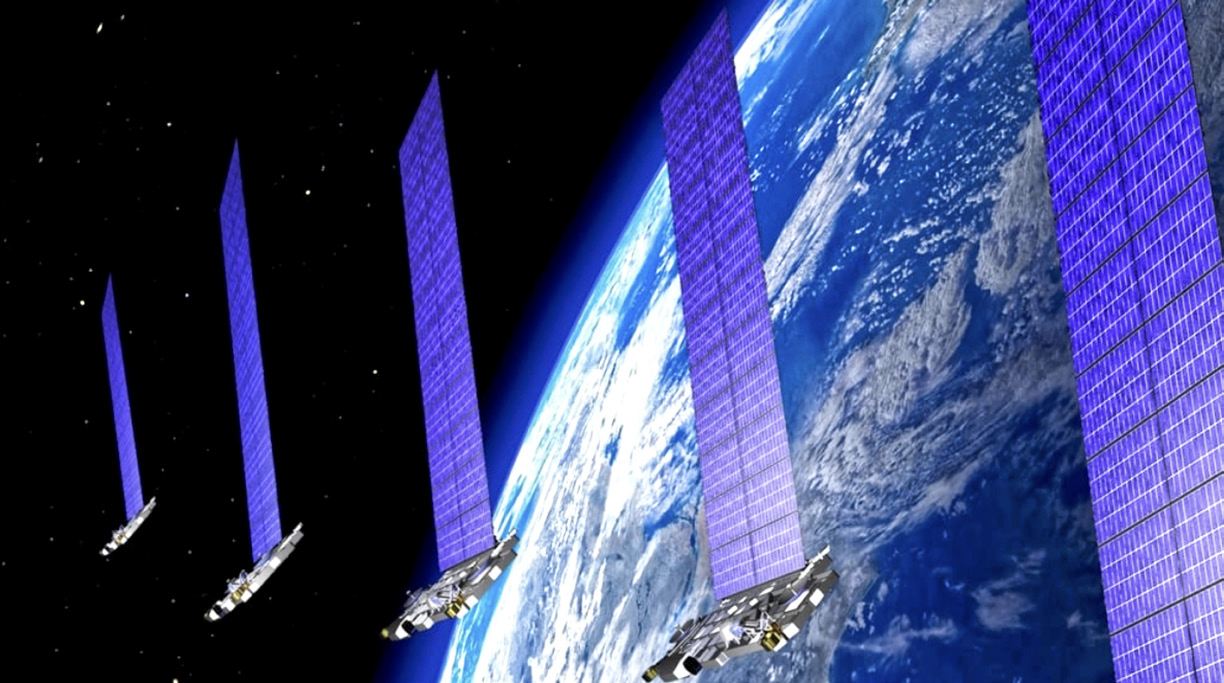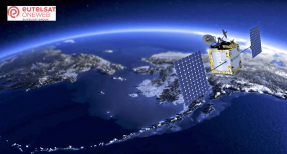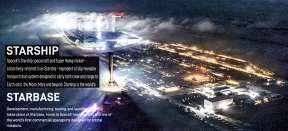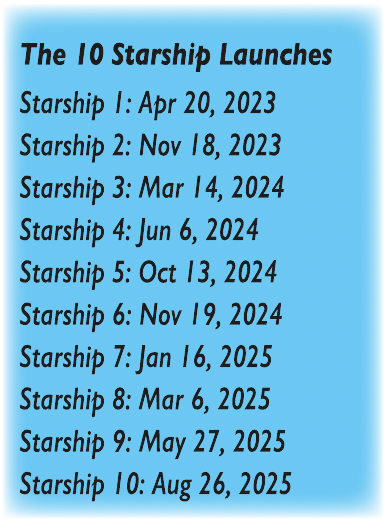Chris Forrester, Senior Columnist, SatNews Publishers
It is only too obvious that Elon Musk’s Starlink broadband-by-satellite system is doing well. Starlink has more than 7 million customers around the world. This number is up from 6 million confirmed in June of this year, and 5 million as of February of this year.
The success of Starlink provokes the question of whether any other satellite operator can possibly challenge this market dominance.

Clearly, Amazon’s Project Kuiper has finance and muscle and is one such contender and has the beginnings of its system now in orbit.
The second ‘most likely’ player is AST SpaceMobile which also has its embryonic satellites now being increased.
Canada-based Telesat’s Lightspeed is still a long way from launching its LEO fleet but could certainly emerge as a regional contender.
Eutelsat’s OneWeb is already service commercial, governmental and institutional LEO demand, but is nowhere near having the impact of Starlink. There are other players, not the least fof which are being developed in China.
As for Starlink’s growth, the number-crunchers say its growth works out at some 12,650 additional new clients a day, on average, since the 6 million mark and represents a growth rate that’s 23% higher than it was just 2.5 months ago. Indeed, it is 1 million new customers in just 79 days. By the time this article appears, another month will have elapsed and Starlink could have achieved another 350,000-400,000 customers. However, churn numbers have not been revealed.

Starlink says it is now connecting clients across about 150 countries and territories. We also know from past releases that SpaceX’s Starlink production lines are turning out 15,000 terminals per day.
As one observer—and user—said, “From a systems engineering perspective, Starlink’s milestone of connecting over 7 million users across ~150 countries and territories is not merely a matter of service adoption—it reflects an extraordinary feat of orbital deployment, network topology optimization, and latency management. The scaling challenges—spectrum allocation, orbital slot management, and signal handoff between rapidly moving nodes—cannot be overstated.”
These Starlink numbers are without many key target markets, including India, Turkey, the Balkan states of Montenegro, Serbia, Bosnia/Herzegovina and the whole of North Africa (Egypt, Libya, Tunisia, Morocco, Algeria, Mauritania and Mali).
Some Middle East nations are still officially unavailable (Saudi Arabia and the UAE) and there are plenty of East and south African countries where service is officially unobtainable (Tanzania, Uganda and South Africa). And the probable non-markets of China and Russia.
SpaceX, and thus Starlink, has no public-facing stock market listing, so hard facts and numbers are difficult to state. However, analysts at consultancy Novaspace (Euroconsult’s new company name), ahead of the recent Paris World Satellite Business Week, suggested that last year SpaceX entered a new phase of commercial maturity. Novaspace says SpaceX’s total revenues are projected to nearly double between2023 and 2025.
Starlink generated $2.7 billion in revenue in 2024, a 93% increase from the $1.4 billion in 2023 suggested Euroconsult at the time. The data came from about $2 billion from subscriptions and more than $736 million from hardware sales, with significant contributions also from the U.S. government and corporate clients.
Starlink has become the airlines favorite supplier and is making considerable inroads into maritime, especially the Cruise industry (where it is working with Luxembourg-based SES). Earlier in September, the Japanese Coast Guard said they would be adopting Starlink.

We’ll examine rival Project Kuiper in a moment, but just consider what Elon Musk’s technical and commercial team have achieved. They have created a world-beating rocket system now with 500 successful landing of the Falcon 1 booster. They have built, launched and deployed more than 2,000 satellites this year (to September 6). Looking at the current deployment rate, SpaceX could deploy 2,800+ Starlink satellites by the close of 2025.
One can only wonder whether this achievement will ever be matched, let alone exceeded. Then there’s Starship, but without the cargo-carrying opportunities provided by the giant Starship, SpaceX’s Starlink is still a money-spinner.
Musk, back in June, said SpaceX will record revenue of about $15.5 billion this year, underscoring the rocket maker’s growing dominance in the commercial space sector. The company’s commercial revenue from space will exceed NASA’s budget of roughly $1.1 billion next year, Musk said in a post on X.
But, in parallel to these spectacular achievements, Musk’s team have also created a near-global subscription and fulfillment system for Starlink customers.
As this column is being written, Kuiper was scheduling its next launch for September 2th5 from
Cape Canaveral. The launch, dubbed KA-03, will be handled by United Launch Alliance’s (ULA) Atlas V551 rocket, depending on the usual weather and range approval permissions.
“This launch continues a new chapter in the commercial launch industry as Amazon partners with ULA to deliver the majority of its advanced satellites to low Earth orbit (LEO),” said ULA in its pre-launch statement.
Flight KA-03 is the third of eight Kuiper missions booked on Atlas V. The mission is scheduled to send another 27 Kuiper satellites into Low Earth Orbit (LEO).
Project Kuiper is Amazon’s LEO satellite broadband network. Its mission, it says, is to deliver fast, reliable internet to customers and communities around the world. “To achieve this goal, Amazon will deploy thousands of satellites in Low Earth Orbit (LEO) linked to a global network of antennas, fiber, and internet connection points on the ground.”

Kuiper, established in 2019, says it expects to begin delivering service to customers in late 2025. Internet service will begin once the first 578 satellites are launched. Project Kuiper’s initial satellite constellation design includes 3,236 satellites. Under its granted FCC license, Amazon is required to launch and operate half of its satellites no later than July 30, 2026, and must launch and operate the remaining satellites no later than July 30, 2029.
Amazon has purchased 92 rocket launches with ULA, France’s ArianeGroup, and Blue Origin (the latter owned by Amazon founder Jeff Bezos) for a total of more than $10 billion. In December of 2023, the company bought three additional launches from SpaceX. Contracts to Blue Origin, owned by Bezos, amounted to 45% of the total launch expenditure.
Three customer terminal designs are planned for different market needs. Project Kuiper’s standard customer terminal is expected to measure less than 11 inches (28 cm) square and 1 inch (2.5 cm) thick, and weigh less than 5 pounds (2.3 kg) without its mounting bracket. The device is planned to deliver speeds up to 400 megabits per second (Mbps). Amazon expects to produce these terminals for less than $400 each.
An ultra-compact design 7 inches (18 cm) square customer terminal, weighing 1 pound (0.45 kg), will offer speeds up to 100 Mbps. This design will connect residential customers for lower-costs, as well as government and enterprise customers pursuing applications such as ground mobility and Internet of Things (IoT) connectivity.
Amazon has one strong advantage: it has its own, near-global distribution system and millions of existing customers to either its Amazon on-line shopping offerings or its Prime Video streaming service—and marketing and billing relationships with all of them.
As of summer 2025, Amazon does not have a formal sign-up page to participate in the planned beta program. Since Amazon is still in the process of testing and launching the first wave of satellites, this program isn’t slated to begin until late 2025 and is only for commercial users. Project Kuiper hasn’t revealed the price of its satellite internet service for future customers. However, it hopes to keep costs down so it can sell Project Kuiper dishes for less than $400.
Without a doubt, the battle for consumer broadband will be between Kuiper and Starlink, and savvy commercial buyers of capacity are already locking their contracts into place. For example, Australia’s Statutory Infrastructure Provider (SIP) NBN Co has selected Amazon’s Project Kuiper to provide satellite broadband to regional, rural and remote areas of the country. Elon Musk’s Starlink was also reportedly in the running for the prized broadband contract, but in a major scoop for Jeff Bezos, Amazon came up trumps, despite Project Kuiper not yet being active.
Then there’s the airline industry where—to date— the likes of Viasat, Intelsat/SES, Panasonic and Thales have dominated. Then out of the blue —so to speak—comes airline jetBlue as a customer of Kuiper. JetBlue is the first operator to select Amazon’s Project Kuiper satellite broadband system.
jetBlue is already using Viasat’s GEO satellites to serve its passengers, and Kuiper will not be fully active until 2027. The airline says it will start to roll out Kuiper in 2027 for about a quarter of its fleet with a phased roll-out to follow. The airline said, “As the first airline in the world to partner with Project Kuiper we’re gearing up to elevate our onboard connectivity for customers to stream, scroll, or share with more ease from gate to gate.”

JetBlue launched its Fly-Fi in-flight service in 2013 to become the first and still only major U.S. airline to offer free, high-speed Wi-Fi on every aircraft in its fleet. Building on that foundation, JetBlue will start to introduce Project Kuiper’s cutting-edge technology on a portion of its fleet in 2027. This planned rollout would mark the next evolution of Fly-Fi and inflight connectivity, with the aim of keeping customers streaming, scrolling and sharing with ease from gate to gate and always for free.
“Our agreement with Project Kuiper marks an exciting leap forward for us as the hands-down leader in onboard connectivity,” said Marty St. George, president, jetBlue. “Whether it’s binge-watching a favorite show, staying connected with loved ones, or wrapping up a work project, we’re always looking for ways to make our customers’ time in the air as connected and productive as they want it to be.”
“Staying connected is part of everyday life, even when you’re traveling,” said Panos Panay, SVP of Amazon Devices & Services. “With Project Kuiper, we’re working to ensure customers can enjoy fast, reliable internet wherever they are—at home or 35,000 feet in the air—and we’re pumped to bring that to life with JetBlue.”
That the market for connectivity exists is clear. But to achieve universal, meaningful Internet connectivity by 2030 could require an investment of $2.6 trillion (€2.2tn) to £2.8 trillion at current prices, according to the Connecting Humanity Action Blueprint released by the International Telecommunication Union (ITU)—the UN agency for digital technologies—and the Communications, Space & Technology Commission (CST) of the Kingdom of Saudi Arabia. The report outlines the challenges, projected costs, and collaborative strategies needed to make sure everyone, everywhere, can use the Internet, including the estimated one-third of humanity currently offline.
The largest investment component—$1.5 trillion to $1.7 trillion—is required for hard infrastructure, alongside substantial funding for human and institutional capacity, mainly in developing countries. This very much assumes terrestrial connectivity.
“Digital connectivity means creating opportunities for education, jobs, and access to essential services that can transform lives and communities,” said ITU Secretary-General Doreen Bogdan-Martin. “While significant resources are needed to meaningfully connect everyone, these are investments that will contribute to a prosperous digital future for all.”
ITU estimates that 2.6 billion people are still excluded from the digital world, with connectivity closely linked to levels of socio-economic development. In 2024, an estimated 93 % of the population in high-income countries was using the Internet, compared to just 27 % in low-income countries.
The report on achieving universal meaningful connectivity builds on ITU’s original 2020 Connecting Humanity study, published under the direction of the G20 during the presidency of the Kingdom of Saudi Arabia, by identifying critical gaps with the anticipated costs for addressing them.
“The world needs between $2.6 trillion and $2.8 trillion to connect humanity by 2030. This figure is nearly five times higher than the last assessment conducted in 2020 in partnership with ITU during the Saudi chairmanship of the G20,” said H.E. Eng. Haytham AlOhali, Acting Governor of CST. “Such a dramatic increase underscores the urgency for international cooperation, collective investment, and the sharing of expertise if we are to achieve the vision of universal, meaningful connectivity for all.”
Not everyone will be able to afford 100% access. Indeed, this where the likes of Eutelsat’s OneWeb steps in, and the Greg Wyler-founded business always assumed that OneWeb’s terminal would grace village halls, community centres, schools, doctor’s surgeries and libraries, no matter how isolated. Eutelsat has yet to start developing this market, instead focusing— with increasing success—on commercial, military/government and similar higher value clients. Eutelsat’s OneWeb is not targeting individual consumers.
Wyler was also a key player in O3b (the “other three billion”) which is now owned by SES and which is busy targeting government, airlines, maritime and business for their capacity demands. O3b is not targeting individual consumers.

There are other players seeking a slice of the market. Top of the list—and already in business—is the Globalstar/Apple combination which wants to serve the Apple iPhone market. Apple put $1.7 billion into Globalstar last November and, in return, received a 20% stake in the satellite business. But while this space-enabled capability now also includes basic texting, the LEO network does not provide for bandwidth-hungry services, such as voice or broadband. Globalstar awarded Canada’s MDA a $327 million contract to build 17 satellites, with options for up to nine additional satellites at $11.4 million each.
Canada’s Telesat is also extremely busy looking to LEO activity to rescue their declining GEO/DTH business. Telesat Lightspeed is planned as a constellation of 198 LEO satellites, with services focused on the enterprise and government sectors and connecting isolated communities over its vast landmass. It already has valuable contracts in place with Canada’s regional governments, for example.
Telesat has booked 14 launches from SpaceX to start launching satellites in the middle of next year, and aims to deploy the entire constellation by mid-2027. Telesat has also signed a potentially valuable contract with Saudi Arabia-based Arabsat. Arabsat will lease multi-gigabit capacity from Telesat’s planned Lightspeed LEO constellation.
Meanwhile, there are other examples of would-be operators. There’s SES-backed Lynk Global. SES is now a major shareholder in Lynk with a strategic partnership to address the high-growth direct-to-device segment. As part of the agreement, SES will provide Series B funding for Lynk Global’s D2D constellation and provide a suite of integrated services that will enhance Lynk Global’s capabilities which includes partnering with SES via its mPOWER mid-Earth orbiting fleet. The plan is to allow SES’s customers to benefit from a broader range of applications including remote access, mission-critical first responder and secure government communications, offshore and automotive connectivity.
There are also regional players (Kacific Broadband is one) as well as would-be operators, such as Rivada Space Networks.

Chris Forrester
But Starlink is going to be the one to beat.
Author Chris Forrester is the Senior Columnist and Contributor for SatNews Publishers and is a well-known broadcasting journalist and industry consultant. He reports on all aspects of broadcasting with special emphasis on content, the business of television and emerging applications.


